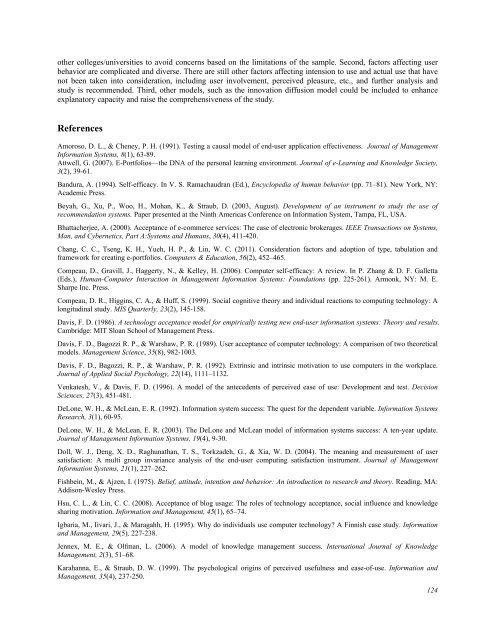October 2012 Volume 15 Number 4 - Educational Technology ...
October 2012 Volume 15 Number 4 - Educational Technology ...
October 2012 Volume 15 Number 4 - Educational Technology ...
You also want an ePaper? Increase the reach of your titles
YUMPU automatically turns print PDFs into web optimized ePapers that Google loves.
other colleges/universities to avoid concerns based on the limitations of the sample. Second, factors affecting user<br />
behavior are complicated and diverse. There are still other factors affecting intension to use and actual use that have<br />
not been taken into consideration, including user involvement, perceived pleasure, etc., and further analysis and<br />
study is recommended. Third, other models, such as the innovation diffusion model could be included to enhance<br />
explanatory capacity and raise the comprehensiveness of the study.<br />
References<br />
Amoroso, D. L., & Cheney, P. H. (1991). Testing a causal model of end-user application effectiveness. Journal of Management<br />
Information Systems, 8(1), 63-89.<br />
Attwell, G. (2007). E-Portfolios—the DNA of the personal learning environment. Journal of e-Learning and Knowledge Society,<br />
3(2), 39-61.<br />
Bandura, A. (1994). Self-efficacy. In V. S. Ramachaudran (Ed.), Encyclopedia of human behavior (pp. 71–81). New York, NY:<br />
Academic Press.<br />
Beyah, G., Xu, P., Woo, H., Mohan, K., & Straub, D. (2003, August). Development of an instrument to study the use of<br />
recommendation systems. Paper presented at the Ninth Americas Conference on Information System, Tampa, FL, USA.<br />
Bhattacherjee, A. (2000). Acceptance of e-commerce services: The case of electronic brokerages. IEEE Transactions on Systems,<br />
Man, and Cybernetics, Part A:Systems and Humans, 30(4), 411-420.<br />
Chang, C. C., Tseng, K. H., Yueh, H. P., & Lin, W. C. (2011). Consideration factors and adoption of type, tabulation and<br />
framework for creating e-portfolios. Computers & Education, 56(2), 452–465.<br />
Compeau, D., Gravill, J., Haggerty, N., & Kelley, H. (2006). Computer self-efficacy: A review. In P. Zhang & D. F. Galletta<br />
(Eds.), Human-Computer Interaction in Management Information Systems: Foundations (pp. 225-261). Armonk, NY: M. E.<br />
Sharpe Inc. Press.<br />
Compeau, D. R., Higgins, C. A., & Huff, S. (1999). Social cognitive theory and individual reactions to computing technology: A<br />
longitudinal study. MIS Quarterly, 23(2), 145-<strong>15</strong>8.<br />
Davis, F. D. (1986). A technology acceptance model for empirically testing new end-user information systems: Theory and results.<br />
Cambridge: MIT Sloan School of Management Press.<br />
Davis, F. D., Bagozzi R. P., & Warshaw, P. R. (1989). User acceptance of computer technology: A comparison of two theoretical<br />
models. Management Science, 35(8), 982-1003.<br />
Davis, F. D., Bagozzi, R. P., & Warshaw, P. R. (1992). Extrinsic and intrinsic motivation to use computers in the workplace.<br />
Journal of Applied Social Psychology, 22(14), 1111–1132.<br />
Venkatesh, V., & Davis, F. D. (1996). A model of the antecedents of perceived ease of use: Development and test. Decision<br />
Sciences, 27(3), 451-481.<br />
DeLone, W. H., & McLean, E. R. (1992). Information system success: The quest for the dependent variable. Information Systems<br />
Research, 3(1), 60-95.<br />
DeLone, W. H., & McLean, E. R. (2003). The DeLone and McLean model of information systems success: A ten-year update.<br />
Journal of Management Information Systems, 19(4), 9-30.<br />
Doll, W. J., Deng, X. D., Raghunathan, T. S., Torkzadeh, G., & Xia, W. D. (2004). The meaning and measurement of user<br />
satisfaction: A multi group invariance analysis of the end-user computing satisfaction instrument. Journal of Management<br />
Information Systems, 21(1), 227–262.<br />
Fishbein, M., & Ajzen, I. (1975). Belief, attitude, intention and behavior: An introduction to research and theory. Reading, MA:<br />
Addison-Wesley Press.<br />
Hsu, C. L., & Lin, C. C. (2008). Acceptance of blog usage: The roles of technology acceptance, social influence and knowledge<br />
sharing motivation. Information and Management, 45(1), 65–74.<br />
Igbaria, M., Iivari, J., & Maragahh, H. (1995). Why do individuals use computer technology? A Finnish case study. Information<br />
and Management, 29(5), 227-238.<br />
Jennex, M. E., & Olfman, L. (2006). A model of knowledge management success. International Journal of Knowledge<br />
Management, 2(3), 51–68.<br />
Karahanna, E., & Straub, D. W. (1999). The psychological origins of perceived usefulness and ease-of-use. Information and<br />
Management, 35(4), 237-250.<br />
124

















